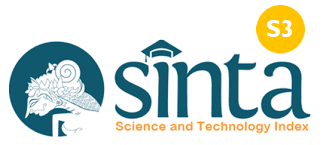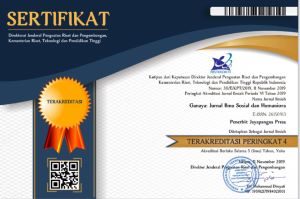Efektivitas Penyuluhan Terhadap Pengetahuan Tentang Teknik Akupresur untuk Meningkatkan Konsentrasi pada Siswa di SMKN 1 Tembuku
DOI:
https://doi.org/10.37329/cetta.v7i3.3289Keywords:
Acupressure, Concentration, StudentsAbstract
Student academic achievement is one of the main indicators used to assess the quality of education. One of the reasons for the low student learning outcomes currently is the lack of student concentration during the learning process. Concentration is the initial aspect of processing information. As for improving learning achievement, students should increase their concentration during the learning process. Acupressure is a therapeutic modality that has been proven to have the function of improving an individual's cognitive abilities. Many studies have found that acupuncture points, which can also be used for acupressure, have the effect of improving cognitive abilities. On this basis, researchers conducted a study related to the effect of health education on students' level of knowledge about acupressure to increase concentration in students at SMKN 1 Tembuku. Respondents were asked to fill out pre-test and post-test questionnaires before and after counseling to measure changes in knowledge. The results showed a significant increase in knowledge scores before and after the extension activities. Knowledge scores about acupressure increased from before (Md = 5.00) to (Md = 9.50) after counseling with a p-value < 0.01. This is also supported by the attitudes of respondents where the majority of respondents stated that they would apply this technique to increase study concentration. Participants' knowledge regarding acupressure to improve concentration have increased after receiving health education. Increasing the knowledge of respondents regarding acupressure techniques is a very good thing. This is because the acupressure technique has a number of benefits in increasing brain development and stimulating the secretion of neurotransmitters and hormones which are important for increasing student concentration. The acupressure technique is easy to use and has no side effects and can be applied by participants independently. Therefore, increasing knowledge of acupressure is very beneficial for school students, especially for those who often experience decreased concentration in studying.
References
Aprilia, D., Suranata, K., & Dharsana, I. K. (2014). Penerapan Konseling Kognitif Dengan Teknik Pembuatan Kontrak (Contingency Contracting) Untuk Meningkatkan Konsentrasi Belajar Siswa Kelas X TKR1 SMK Negeri 3 Singaraja. Jurnal Ilmiah Bimbingan Konseling Undiksha, 2(1).
Ardila, A., & Hartanto, S. (2017). Faktor Yang Mempengaruhi Rendahnya Hasil Belajar Matematika Siswa Mts Iskandar Muda Batam. Pythagoras: Jurnal Program Studi Pendidikan Matematika, 6(2).
Arora, R. (2016). Academic Achievement Of Adolescents In Relation To Study Habits. The International Journal of Indian Psychology, 3(2), 47–54.
Flor, R. K., Monir, K. C., Bita, A., & Shahnaz, N. (2013). Effect Of Relaxation Training On Working Memory Capacity And Academic Achievement In Adolescents. Procedia-Social and Behavioral Sciences, 82, 608–613.
Hmwe, N. T. T., Subramanian, P., Tan, L. P., & Chong, W. K. (2015). The Effects Of Acupressure On Depression, Anxiety And Stress In Patients With Hemodialysis: A Randomized Controlled Trial. International Journal of Nursing Studies, 52(2), 509–518.
Hsu, H.-C., Tseng, K.-Y., Fang, H.-Y., Huang, T.-M., Kuo, C.-C., Chen, L.-L., & Ma, W.-F. (2022). The Effects Of Acupressure On Improving Health And Reducing Cost For Patients Undergoing Thoracoscopic Surgery. International Journal of Environmental Research and Public Health, 19(3), 1869.
Jain, A., Mishra, A., Shakkarpude, J., & Lakhani, P. (2019). Beta Endorphins: The Natural Opioids. Ijcs, 7(3), 323–332.
Ji, S., Duan, J., Hou, X., Zhou, L., Qin, W., Niu, H., Luo, S., Zhang, Y., Chan, P., & Jin, X. (2021). The Role Of Acupuncture Improving Cognitive Deficits Due To Alzheimer’s Disease Or Vascular Diseases Through Regulating Neuroplasticity. Neural Plasticity, 2021.
Kamoru, U., & Ramon, O. G. (2017). Influence of Self-Concept, Study Habit and Gender on Attitude and Achievement of Secondary School Students in Mathematics. Journal for Leadership and Instruction, 16(1), 49–52.
Khayra Al, M., & Imandiri, A. (2018). Terapi Akupresur Serta Herbal Kencur Pada Kasus Migrain. Journal of Vocational Health Studies, 2, 80–85.
Labibah, L. N., Indah, M. N., Pata, M. H. E., Farida, N. A., & Makbul, M. (2024). Meningkatkan Konsentrasi Belajar Pada Pembelajaran PAI Dengan Metode Kooperatif Tipe TGT (Teams Games Tournament). Jurnal Ilmu Pendidikan Islam, 23(2), 385–395.
Lawrence, A. S. (2014). Relationship between Study Habits and Academic Achievement of Higher Secondary School Students. Online Submission, 4(6), 143–145.
Lin, C.-J., Yeh, M.-L., Wu, S.-F., Chung, Y.-C., & Lee, J. C.-H. (2022). Acupuncture-Related Treatments Improve Cognitive And Physical Functions in Alzheimer’s Disease: A Systematic Review And Meta-Analysis Of Randomized Controlled Trials. Clinical Rehabilitation, 36(5), 609–635.
Malawi, I., & Tristiar, A. A. (2016). Pengaruh Konsentrasi Dan Kemampuan Berpikir Kritis Terhadap Prestasi Belajar IPS Siswa Kelas V SDN Manisrejo I Kabupaten Magetan. Premiere Educandum: Jurnal Pendidikan Dasar Dan Pembelajaran, 3(02).
Marzatifa, L., Agustina, M., & Inayatillah, I. (2021). Ice Breaking: Implementasi, Manfaat Dan Kendalanya Untuk Meningkatkan Konsentrasi Belajar Siswa. Al-Azkiya: Jurnal Ilmiah Pendidikan MI/SD, 6(2), 162–171.
Mehta, P., Dhapte, V., Kadam, S., & Dhapte, V. (2017). Contemporary Acupressure Therapy: Adroit Cure For Painless Recovery Of Therapeutic Ailments. Journal of Traditional and Complementary Medicine, 7(2), 251–263.
Moyer, C. A., Seefeldt, L., Mann, E. S., & Jackley, L. M. (2011). Does Massage Therapy Reduce Cortisol? A Comprehensive Quantitative Review. Journal of Bodywork and Movement Therapies, 15(1), 3–14.
Odiri, O. E. (2015). Relationship of Study Habits with Mathematics Achievement. Journal of Education and Practice, 6(10), 168–170.
Pratiwi, I., Hendrik, H., Atmadireja, G., Utama, B., & Waspodo, R. M. (2019). Konsentrasi Belajar Siswa SMA dan Penggunaan Gawai. Pusat Penelitian Kebijakan Pendidikan dan Kebudayaan.
Roza, R., Mulyadi, B., Nurdin, Y., & Mahathir, M. (2019). Pengaruh Pemberian Akupresur oleh Anggota Keluarga terhadap Tingkat Nyeri Pasien Nyeri Kepala (Chephalgia) di Kota Padang Panjang. Jurnal Ilmiah Universitas Batanghari Jambi, 19(3), 714–717.
Sa’adah, N., Sumarwiyah, S., & Kusmanto, A. S. (2024). Penerapan Konseling Cognitive Behavior Therapy untuk Meningkatkan Konsentrasi Belajar Siswa SMA N 1 Gebog Kudus. Jurnal Muria Research Guidance and Counseling (MRGC), 3(1), 27–34.
Saputra, Y. W. A. (2020). Pengaruh Bimbingan Kelompok Dengan Teknik Reinforcement Positif Dan Self Management Untuk Meningkatkan Konsentrasi Belajar. Edukasi: Jurnal Penelitian Dan Artikel Pendidikan, 12(1), 11–28.
Surur, S. F. (2019). Implementasi Ice Breaking Dalam Meningkatkan Minat Belajar Siswa di MI Riyadlotul Uqul Doroampel Sumbergempol Tulungagung.
Zeng, H., Liu, M., Wang, P., Kang, J., Lu, F., & Pan, L. (2016). The Effects Of Acupressure Training On Sleep Quality And Cognitive Function Of Older Adults: a 1‐Year Randomized Controlled Trial. Research in Nursing & Health, 39(5), 328–336.
Zullo, A., Mancini, F. P., Schleip, R., Wearing, S., Yahia, L., & Klingler, W. (2017). The Interplay Between Fascia, Skeletal Muscle, Nerves, Adipose Tissue, Inflammation And Mechanical Stress In Musculo-Fascial Regeneration. Journal of Gerontology and Geriatrics, 65(4), 271–283.
Downloads
Published
How to Cite
Issue
Section
License
Copyright (c) 2024 Ida Ayu Anom Rastiti, Ida Ayu Suptika Strisanti, Asthadi Mahendra Bhandesa

This work is licensed under a Creative Commons Attribution-ShareAlike 4.0 International License.
An author who publishes in the Cetta : Jurnal Ilmu Pendidikan agrees to the following terms:
- Author retains the copyright and grants the journal the right of first publication of the work simultaneously licensed under the Creative Commons Attribution-ShareAlike 4.0 License that allows others to share the work with an acknowledgement of the work's authorship and initial publication in this journal
- Author is able to enter into separate, additional contractual arrangements for the non-exclusive distribution of the journal's published version of the work (e.g., post it to an institutional repository or publish it in a book) with the acknowledgement of its initial publication in this journal.
- Author is permitted and encouraged to post his/her work online (e.g., in institutional repositories or on their website) prior to and during the submission process, as it can lead to productive exchanges, as well as earlier and greater citation of the published work (See The Effect of Open Access).
Read more about the Creative Commons Attribution-ShareAlike 4.0 Licence here: https://creativecommons.org/licenses/by-sa/4.0/.





